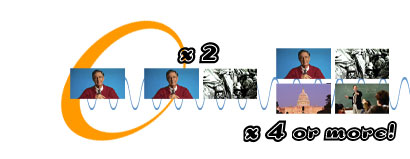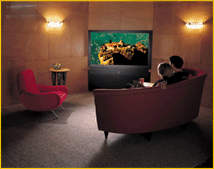
 HDTV
TECHNOLOGY
HDTV
TECHNOLOGY

![]() INTRODUCTION
INTRODUCTION
In 1996, the Federal Communications Commision (FCC) approved the digital television broadcast standards for the United States. All Digital Television (DTV) broadcasts will be on UHF channels and the current analog TV broadcast, and all VHF television broadcasts, will be phased out at the end of 2006.
While the FCC doesn't enforce video resolution standards for DTV, the manufacturers came up with 18 combinations of resolution, scanning rates and scanning mode. The highest resolution mode is 1920 x 1080 pixels per square inch. This mode uses "interlaced" scanning as does today's analog TV. With interlaced scanning, the odd numbered scanning lines (1,3,5, etc) are displayed in the first 1/60 second and the remaining even numbered lines are displayed in the next 1/60 second. By combining these two "fields," one complete frame of the video is displayed every 1/30 second. Some of the standard and medium resolution DTV modes use progressive, or non-interlaced, scanning. With this mode, all of the scanning lines are displayed sequentially (1,2,3,4,5,etc). This is the method used in modern computer displays and generally produces less flicker in the displayed image and smoother motion for video. The letter "I" or "P" is used often along with the resolution number. For example, a HDTV set's specification sheet will usually say that it supports 1080I, meaning that the resolution is a 1920 x 1080 "Interlaced" mode.
All this technical information
ultimately means that viewers at home will be able to receive high-quality,
crystal-clear pictures, with many times more resolution and clarity than
that of standard televisions. All this will be displayed on a wide
screen format with a 16x9 width to height ratio compared to today's 4x3,
or basically square format. Also, because HDTV is digital, audiences
will have six-channel CD quality surround sound. In other words,
it will be a true home theater experience.
![]() MULTICASTING
MULTICASTING
When not transmitting in high definition
HDTV, broadcasters will beable to transmit four of more channels of standard
definition television (SDTV) programming simultaneously. This is
called multicasting. Although SDTV will not match HDTV in quality,
it will offer a higher quality picture than we have today.

This means that with multicasting technology, your local station will be able to transmit several programs with supplemental data simultaneously. For example:
On History Channel 1
The young child in the family watches an educational program
while her parents download activities that expand on the
themes raised in the program.
On History Channel 2
The young child's older brother learns about WWII. Later he
can quiz himself with a quiz that is broadcast simultaneously.
On History Channel 3
The father can hear a live congressional hearing. While the
hearing is being broadcast he can read proposed legislation
and political commentary.
On History Channel 4
The college student in the family is taking an Adult Learning
Service continuing education course. At the same time they
can download a study guide and the course syllabus.
![]() ENHANCED
PROGRAMMING
ENHANCED
PROGRAMMING
Digital broadcasting will offer millions of viewers, families, and educators a new form of programming that is greatly different than before: enhanced digital television. Enhanced TV combines video, audio, images and text in an entirely new medium.
Television prducers will be able to combine video and film with the giant data channel of a digital signal. Viewers will be able to simultaneously watch an enhanced TV production, and in the backround, receive hundreds of megabytes of additional video, audio, text, and images related to the program.

You won't need a modem connection to experience enhanced programming(although some Web links may be available to you for further information.)
![]() DIGITAL
TELEVISION TOWERS
DIGITAL
TELEVISION TOWERS
In order to provide DTV service while continuing to broadcast their analog programs, many television broadcasters may have to modify their transmission towers or construct new towers. Before modifying or building new towers, broadcasters may need to get approval from the state, city, or county governments regarding local zoning issues, your local government has the authority to make sure that any new construction is safe.
The National Association of Broadcasters argue that the local zoning regulations make it impossible for many broadcasters to meet the schedule for the introduction of DTV. They believe that the process of gaining approval from local authorities may take so long that the broadcasters won't be able to modify or construct their DTV towers in time to make DTV available on schedule. The N.A.B. asked the the FCC to enforce a rule that preempts local regulations so they can meet the FCC deadline.
![]() WHEN
WILL HDTV ARRIVE NEAR YOU?
WHEN
WILL HDTV ARRIVE NEAR YOU?

This graph originated at CEMA, Consumer Electronics Manufacturers Association,
located at www.omnilan.com/dtv_rollout.htm